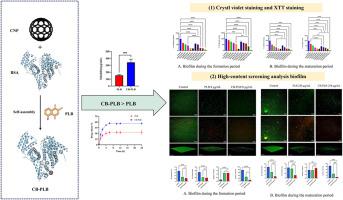用于铅白丹苷递送的功能化碳纳米颗粒:物理化学表征、抗菌活性和分子对接
IF 4.9
3区 医学
Q1 PHARMACOLOGY & PHARMACY
Journal of Drug Delivery Science and Technology
Pub Date : 2025-09-19
DOI:10.1016/j.jddst.2025.107551
引用次数: 0
摘要
细菌生物膜在慢性伤口感染中发挥关键作用,显著延缓伤口愈合。金黄色葡萄球菌是最常见的生物膜形成病原体之一,分泌细胞外聚合物质,有效地保护其免受宿主免疫防御和抗生素治疗。为了解决这一挑战,纳米级抗菌策略近年来引起了越来越多的关注。通过将抗菌药物包裹在纳米载体中,可以增强药物对生物膜的渗透,从而提高生物利用度。本研究采用功能化方法合成了牛血清白蛋白功能化纳米碳(CB)。随后将抗菌剂白丹素(PLB)加载到其上,形成纳米复合材料(CB-PLB)。我们全面表征了它们的物理化学性质,包括粒径、多分散性指数、形貌、载药效率、热行为(差示扫描量热法,DSC)、结晶度(x射线衍射,XRD)、光谱特征、溶解度和体外药物释放谱。具体来说,我们研究了CB-PLB对金黄色葡萄球菌生物膜形成和成熟生物膜的影响。结晶紫染色和XTT检测结果表明,CB-PLB对形成的和成熟的生物膜具有较好的抗菌和抗生物膜活性。高含量筛选成像分析证实,CB-PLB具有强大的破坏性作用,包括生物量的减少、平均厚度和生物膜粗糙度的改变。此外,分子对接分析证实了碳纳米颗粒(CNP)、PLB和牛血清白蛋白(BSA)之间的特异性相互作用。这些发现强调了CB与PLB之间的协同相互作用,表明CB是一种很有前途的疏水抗菌剂纳米载体。本文章由计算机程序翻译,如有差异,请以英文原文为准。

Functionalized carbon nanoparticles for plumbagin delivery: Physicochemical characterization, antibacterial activity, and molecular docking
Bacterial biofilms play a critical role in chronic wound infections by significantly delaying wound healing. Staphylococcus aureus, one of the most prevalent biofilm-forming pathogens, secretes extracellular polymeric substances that effectively protect it from host immune defenses and antibiotic treatments. To address this challenge, nanoscale antibacterial strategies have attracted increasing attention in recent years. By encapsulating antibacterial agents within nanocarriers, drug penetration into biofilms can be enhanced, thereby improving bioavailability. In this study, we synthesized bovine serum albumin-functionalized carbon nanoparticles (CB) via the functionalization method. The antibacterial agent plumbagin (PLB) was subsequently loaded onto them to form nanocomposites (CB-PLB). We comprehensively characterized their physicochemical properties, including particle size, polydispersity index, morphology, drug-loading efficiency, thermal behavior (differential scanning calorimetry, DSC), crystallinity (X-ray diffraction, XRD), spectroscopic features, solubility, and in vitro drug-release profiles. Specifically, we examined the impact of CB-PLB on both biofilm formation and established mature biofilms of Staphylococcus aureus. In comparison to PLB, CB-PLB showed better antibacterial and anti-biofilm activity against formed and matured biofilm using crystal violet staining and XTT assay. High-content screening imaging analyses confirmed that CB-PLB exerted potent disruptive effects, including reduction of biomass, mean thickness, and alteration of biofilm roughness. Furthermore, molecular docking analysis confirmed specific interactions among carbon nanoparticles (CNP), PLB, and bovine serum albumin (BSA). These findings highlight the synergistic interaction between CB and PLB, suggesting that CB is a promising nanocarrier for hydrophobic antibacterial agents.
求助全文
通过发布文献求助,成功后即可免费获取论文全文。
去求助
来源期刊
CiteScore
8.00
自引率
8.00%
发文量
879
审稿时长
94 days
期刊介绍:
The Journal of Drug Delivery Science and Technology is an international journal devoted to drug delivery and pharmaceutical technology. The journal covers all innovative aspects of all pharmaceutical dosage forms and the most advanced research on controlled release, bioavailability and drug absorption, nanomedicines, gene delivery, tissue engineering, etc. Hot topics, related to manufacturing processes and quality control, are also welcomed.

 求助内容:
求助内容: 应助结果提醒方式:
应助结果提醒方式:


